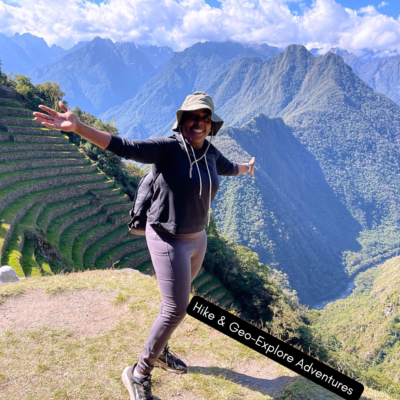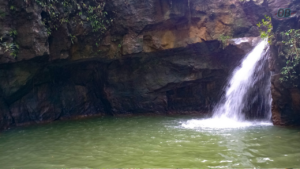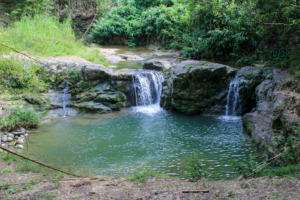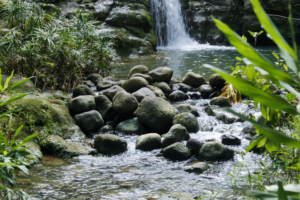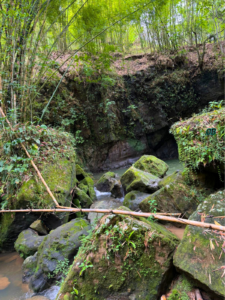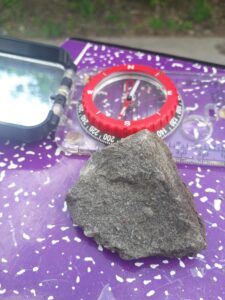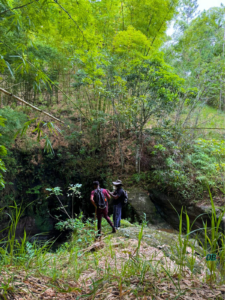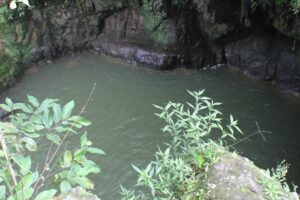Are George Hole and Christiana Blue Hole, random holes turned waterfall pools of the valley floor (river bed), or, are they connected relics of volcano craters (extinct) which existed as a chain of active submarine-aerial volcanoes, back in Jamaica’s earlier geologic history?
How is it that that while walking along and adjacent to the river bed, where both the Christiana Blue Hole and George Hole are found, the slope (descent) transition so abruptly to form these relatively deep waterfall pools?
When I assessed the rock makeup (field observations) of both of these attractions, I see that both of these waterfall-pools have closely similar geology. So given this, the theory of these circular pools being formed as a result of carbonate or evaporite beds, is thrown out the window. The Jamaican Caves Organization position is that of classifying George Hole as a sinkhole. While this classification in my view is generally correct, it cannot be determined what is/are the potential factors that’ve resulted in the sinkhole formation of George Hole, and Christiana Blue Hole in extension.
Here enters our Volcano Crater Theory.
George’s Hole & Christiana Blue Hole Formation: The Volcano Crater Theory
Jamaica’s Geology literature highlight that active volcanism existed. Evidence of this active volcanism can be seen in the rocks that are characteristic of volcanoes of the past.
These said rocks through their locations on active volcanoes today, give an indication of the nature of active volcanoes that existed in the past. Irrespective of their explosive nature, all volcanoes have a vent whereby magma from within the earth, exit the vent, and enter the earth’s surface. It’s these vents that generally end up becoming craters (areas of depression/sinkhole relative to the flanks). These said craters, can become filled with water, and become crater lakes.

Join our Upcoming Excursion(s). Click Here.
In Jamaica’s case (specifically George Hole & Christiana Blue Hole), these water-filled craters can form as relatively deep waterfall features of the Cave River.
What still had me puzzled, is why both of these waterfall pools exist approximately 80 meters apart. This is where
I began to theorize that these extinct volcanic craters are relics of an active volcanic arc (chain). It is possible that the bed of the cave river is host of other volcanic craters/sinkholes, turned waterfall pools along its length.
Brief Description of Rocks That Make Up George Hole
Vertical (12ft-15ft) observation of the circular perimeter of the Georges Hole (from within the center), highlight rounded rocks (pillow) that are grey-black to black in color. Sub-horizontal layering of dark brown-brown rocks. Followed by another layer of grey-black rocks with sub-vertical jointing and shearing.
Read: Christiana Blue Hole Waterfall, Jamaica | Directions & Overview
Other Characteristics & Observations: George Hole Waterfall
Animals
River Crab: dark brown in color, approximately 3-5 inches in length.
Water Depth
Deeper than Christiana Blue Hole (estimated minimum at deepest point is 10ft.
General Cross-Section Terrain & Waterfall Access
Steep flanks and deep circular crater in the center.
As attractions, both George Hole & Christiana Blue Hole holds immense eco-tourism value. This value is not just in their current beauty as waterfalls & pools, but also in their value as potential extinct volcanic craters of Jamaica.
Fulljoy.
About The Author
Oshane Bryant: BSc Geology, Geography Minor; ACE CPT since 2012; Jamaica Business Development Corporation (JBDC) Accelerator Graduate-2018 cohort; Licensed KUKIBO Martial Arts & Self Defense, Senior Instructor; CSA Certified Executive Protection; OB Fitness Founder & Managing Director.


